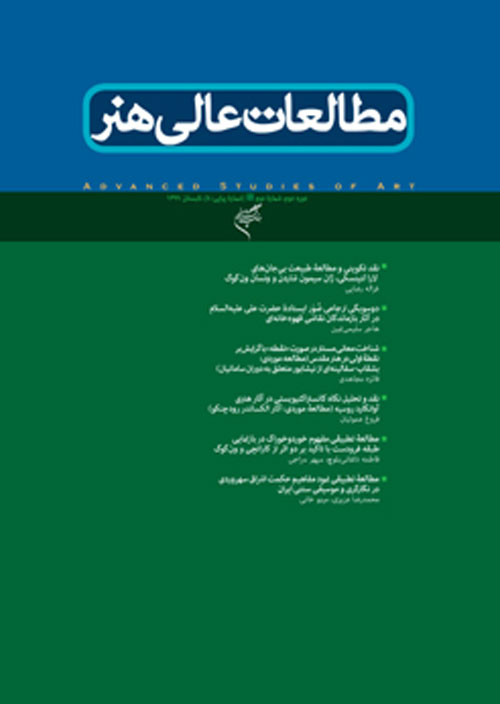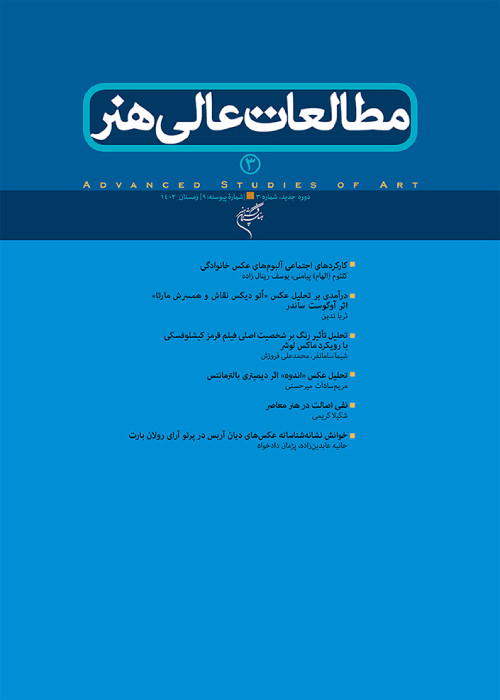فهرست مطالب

نشریه مطالعات عالی هنر
سال دوم شماره 2 (تابستان 1399)
- تاریخ انتشار: 1399/10/17
- تعداد عناوین: 6
-
Pages 7-33
Genetic criticism mainly focuses on “Avant-texte(s)” and analyses the preparatory documents rather than the final and published texts or works of art. Having originated in literary studies, the approach is also used in visual art studies, thus, it can be used in studying the ways in which a work of art (as a text) is created. The following essay focuses on the works and drafts of three artists, Laura Letinsky, a contemporary photographer and the paintings of Jean Baptiste Simeon Chardin and Vincent van Gogh’s still lifes. The still life genre is the shared joint subject matter of this study. The drafts and the contexts in which the works are created are mentioned and categorized based on Bahman Namvar Motlagh and Allah- Shokr Asadollahi’s. The case studies, explore aspects that are crucial to the process of artistic creation of the artworks such as personal conditions and social contexts that have influenced the artists and their art-making practices. In final section of the essay, the collected data will be presented as three tables —- each table representing one of the selected artists — based on the introduced classification of the drafts.
Keywords: Genetic Criticism, Avant-texts, still life, Laura Letinsky, Jean Baptist Simone, Vincentvan Gogh -
Pages 35-59
The aim of the present research was to intertextual study of the standing images of Hazrat Ali ibn Abi Talib (AS) in the works of the survivors of coffee house painting and have been written in an overlapping range of painting, coffee house painting, miniature, poster, Islamic history, hadith, and narration. Imam Ali (AS) stands alone and carries Zulfiqar with him, in these images. This study seeks to challenge the public’s belief that the reference to the figure and Zulfiqar of Imam Ali is purely historical. In this regard, the authors have identified the standing images of Imam Ali (AS) from the contemporary period to the Qajar period, and they have surveyed with the approach of intertextual and transtextual theory of Genette. They have tried to show that these images, in addition to history, refer to previous pictorial texts. According to Islamic hadiths and narrations, the first standing images of Imam Ali (AS) existed both in the Divine Throne and in the coffin of Prophet Adam (AS). These images were created by the command of God, so the first images of Imam Ali (AS) were spiritual, and the choice of Zulfiqar as a sign of Imam Ali (AS) was also spiritual. According to these hadiths and narrations, the standing figure and the presence of Zulfiqar can be mentioned as the principles or protocols of the standing images of Imam Ali (AS) and considering the observance of these protocols in the works of the survivors of the coffee house paintings, It can be claimed that these works are located at the end of the series that its head reaches to the spiritual images of the Imam Ali (AS). Thus, the images of Imam Ali (as) in the works of the survivors of the coffee house painting have the explicit and implicit intertextual, imitation hypertextual, and the stylistic-thematic derivation relationship with the pictorial and written previous texts.
Keywords: Intertextuality, transtextuality, Hazrat Ali Ibn Abi Talib (AS), Zulfiqar, coffee house painting, image -
Pages 61-71
This research is focused on a ceramic plate, made in the third or forth century A.H., which is called »the Ascending Dot« and is encompassed in the circle of the» Sacred Art« and the primary goal of this research is to interpret (dot) on the basis of the mystical teachings and to render the deconstructional role of this plate in contrast with the systematic order. The comparison between the Deconstructional process and the Reception Theory is the secondary goal of this research. There was no history of focused research about this plate in literature review before this essay. The data of this fundamental_ applied research has been gathered through documentary and library study, descriptive analytical data analysis and critical approach. The result shows that »the Ascending Dot« tends to stimulate and interact the holders in comparison with the» Central Absorptive Point«. »The Ascending Dot« in a cyclic movement descends from the Essence of the Graceful Soul and is manifested in descending arch (circle) from inner and unseen Self (DOT), and thus disclosed in multiplicity and in ascending arch (of the circle), is coming back to the Eternal Unity. The returning journey of the seeker or the encircled existence, that is a manifestation of »the ultmate truth«, toward (Fana, extinction of the individual being) is revolving around this Circle of Existence. The usage of Inscribed Plates as the dish of food can have a Cathartic effect (White Death) on the seeker, and even can be a (Dhikr), or remembrance (of God), for him. The Cathartic effect or (white death) is an austerity which purify the seeker through the pain of hunger and help him to find self- control in agony. This is similar to Vedic Sacrifice Ceremony which evokes the unity of Sense of beuty, Taste and Ecstasy.
Keywords: Sacred Art, Point, Absorptive Point, Ascending Dot, DOT, Ceramic plate from Neyshābūr -
Pages 73-89
The Constructivist movement emerged in the early 20th century, following the discovery of the intellectual and political currents of the society, as well as the Russian revolution and the change of artists’ commitments between 1917 and 1935 and left behind works of architecture, industrial design, picture communication, interior furniture, painting, photography, fashion and advertisement. Creating works by architects and designers for producingpurposeful materials has taken steps toward products that, instead of using the designers’ internal motivation and inspiration, are based on the process of producing a product with measurable logic for efficient use. The history of science and technology in the twentieth century of Russia is linked to the political experiences. The avant-garde art that has emerged from the modern societies is no exception. One of the important elements in constituting the modern art was undoubtedly the industrial revolution, through which the avant-garde artists working in the field of art and society acted revolutionary in line with the ideology of the revolution, that is, Marx’s thoughts. Functionalism and attention to the progress of the industry on the one hand andon the other hand, the social, economic, and political changes; the anti-art movement in the form of a slogan of “Death to Art”, “Long Live Technology,” fromthe constructivist artists made specialists in construction, focusing on materials and purity of color, and emphasizing geometry and construction laws. The purpose of this research is to study the indices of constructivist style in Russian avant-gardeproduct and artworkwith an approach to the works of Alexander Rodchenko. It should be noted that this research is descriptive- analytical in terms of its methodology and fundamental in terms of its purpose. The subject of this research is to find the theoretical foundations of the constructivist style in the works of Russian avant-garde artists, especially Rodchenko. The question that the research seeks to answer is: How is Capitalism criticism illustrated in the artworks of Alexander Rudchenko’s works? The structure of the paper is that first it reviews the background and conceptual foundations of constructivist design. Then, considering the indices ofconstructivist style, a number of works by Rudchenko, as cases for a case study of the indices of constructivist styleofRussian artworks have been selected and analyzed. As the characteristics of these works are described in seven tables, the research question is answered as well. Several factors from theanalyses of Rudchenko’s work by constructivist style designing variables can be mentioned as more significant ones with higher frequency in the works of Rudchenko. On this basis, the degree of proximity of Rudchenko’s works to the determining indices of constructivism can be rated. By evaluating the rating of the works in the form of defined variables, the contribution of Alexander Rudchenko to the formation of Russian constructivist can be determined. The result of the research indicates that from the analyses of Rudchenko’s work by constructivist style designing variables, several factorscan be mentioned as more significant ones with higher frequency in the works of Rudchenko.On this basis, the degree of proximity of Rudchenko’s works to the determining indices of constructivism can be rated such as utility, geometry of form and logical order, simplicity in final execution, mass production in industry, purity of materials and negation of capitalism.
Keywords: Constructivism, Russian avant-garde art, Rudchenko, Criticism of Capitalism -
Pages 91-113
Food is one of the elements we encounter throughout our daily lives. This important element has often been overlooked in the discussion of thinkers and philosophers due to its roots in instincts, material and physical needs. This article intends to show the semantic importance of food by examining food in painting. What is meant by the importance of food meaning in painting is whether these objects only play a role in filling the background of the image or not? are they pointless and meaningless? How can they be explored to make more sense? In this study, while paying attention to the semantic importance of food and feed in the works of painters and its relationship with the social class of the people in the picture, the paintings named the bean-eater by Annibale Carracci and tomato-eaters by Vincent van Gogh have been studied. These two works are similar in the elements of image, content or subject (eating), and the social class of the people in the painting (peasant or inferior class of society). The theoretical method of research is the method of archeology of Ervin Panofsky, that is, the description, interpretation and analysis the elements of works (here food).
Keywords: Food, Vincent van Gogh, Annibale Carracci, Meaning -
Pages 115-141
The Philosophy of Suhrawardi's Illumination including Iranian-Islamic concepts can be a basis for examining the subject of ruling in traditional arts. The existence of ontology and the epistemological status of beauty as a concept and the beautiful matter as its research aspect have provided the grounds for aesthetic reflections in this regard. Despite the historical breakthroughs and the influence of foreign cultures, the developments of Iranian miniature and traditional music have been relatively continuous and there are many formal and thematic commonalities in the works of different periods. The purpose of this study was to answer the question of what are the differences and similarities in the way the concepts of Illumination phiosophy are expressed in Iranian traditional music and painting. The method of this research was applied-theoretical in terms of purpose and descriptive-analytical in terms of method of implementation with an adaptive approach. The information was also obtained through library methods. The results show that the concepts of Illumination Philosophy have been manifested as content in Iranian painting and music, and Iranian miniature and music in the position of the form are the manifestation of the concepts of Illumination Philosophy. This two-way relationship suggests that there are precise concepts behind artistic forms, which are the reasons for the formation of structure and examples in the field of miniature and traditional music and in other words, the language that expresses these concepts.
Keywords: Aesthetics, Illumination Philosophy, Suhrawardi, miniature, traditional music


